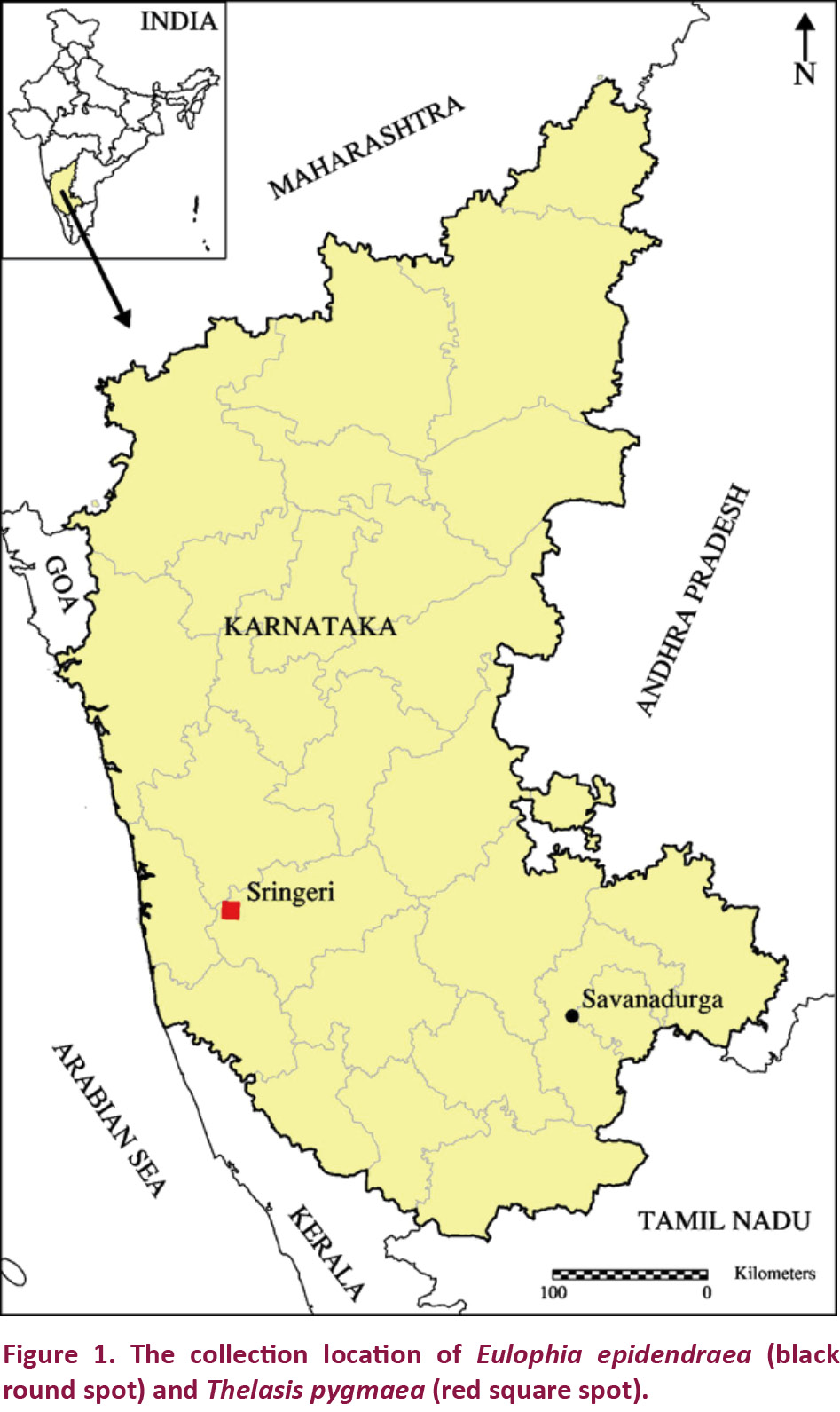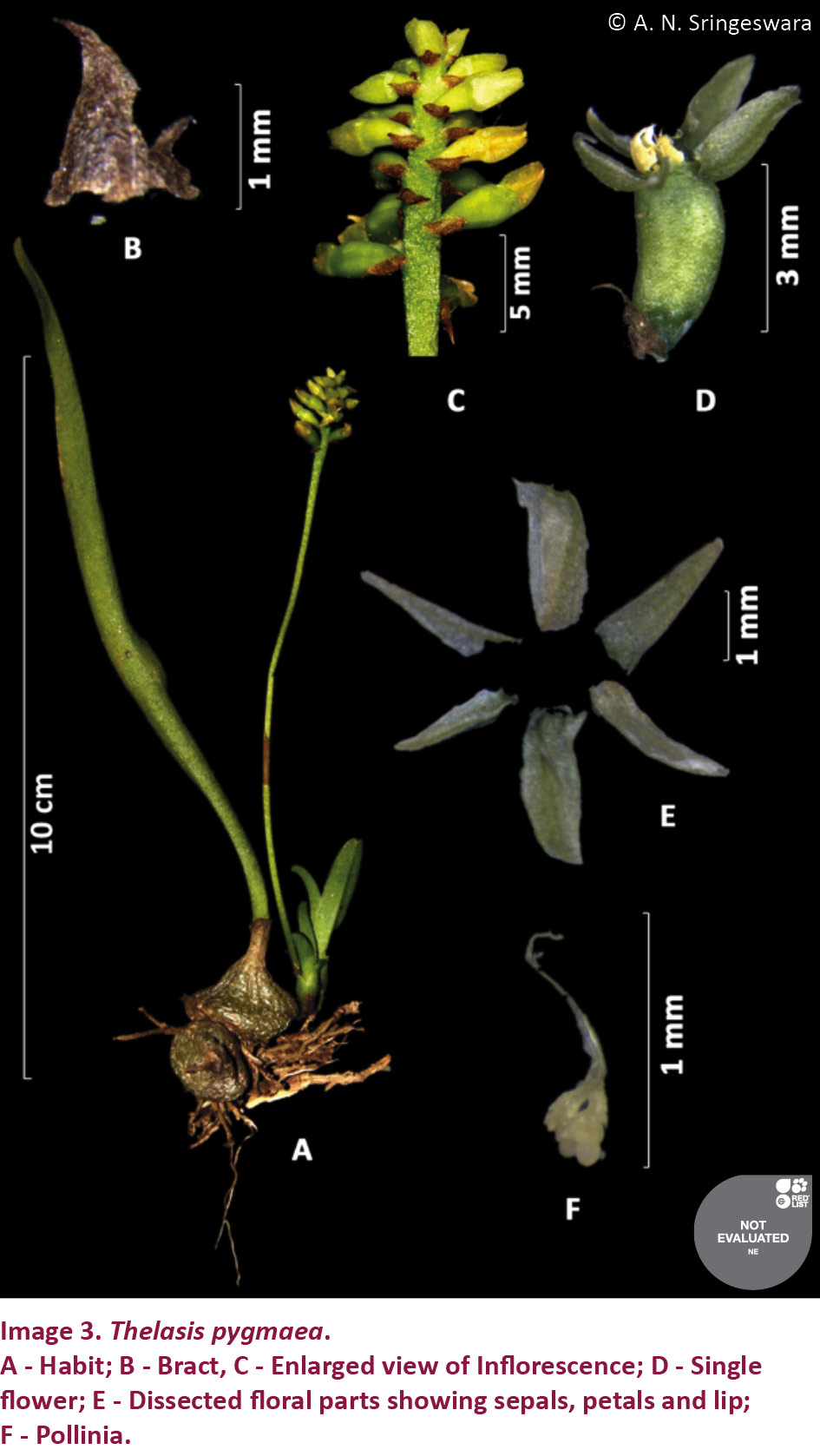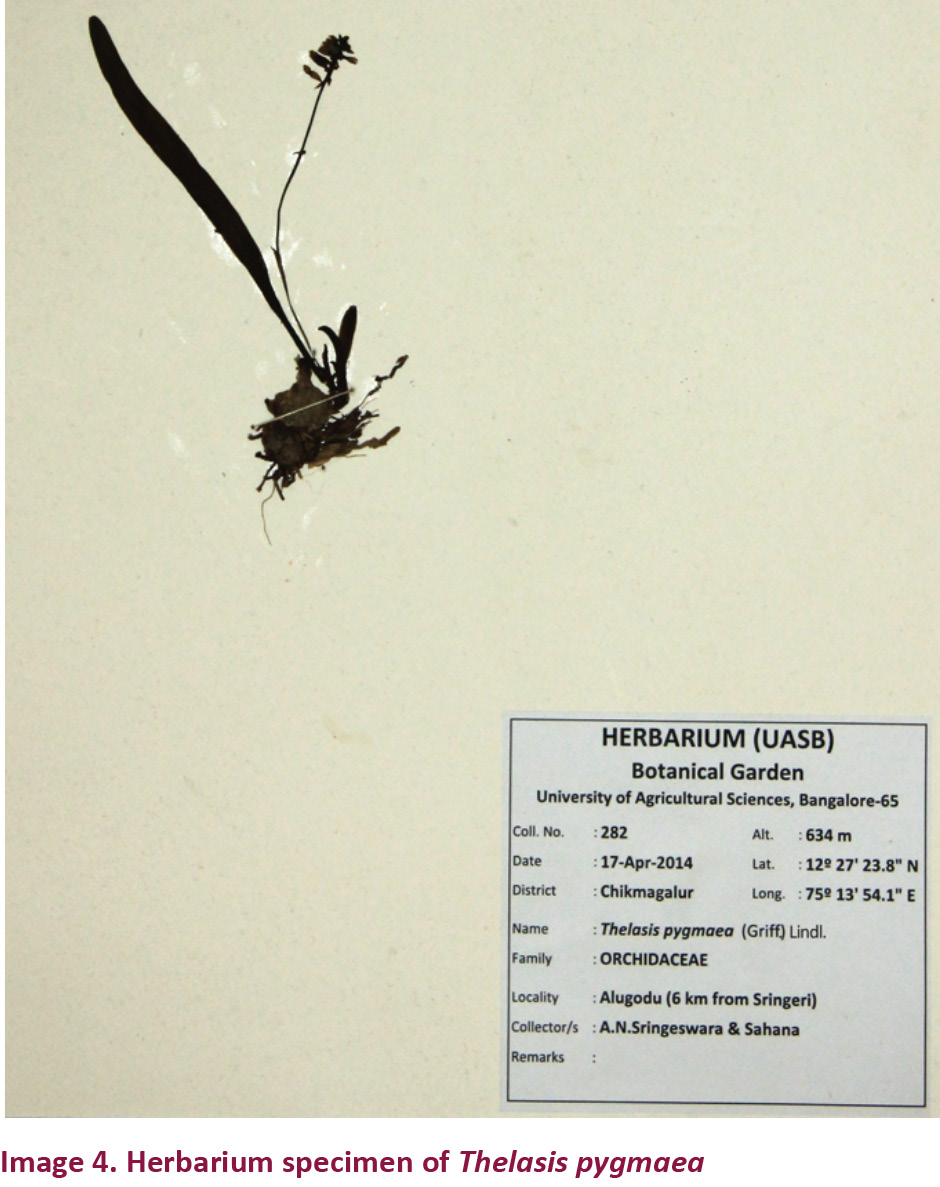Eulophia epidendraea (J. Koenig ex Retz.) C.E.C. Fisch. and Thelasis pygmaea (Griff.) Lindl. (Orchidaceae) - new additions to the flora of Karnataka, India
A.N. Sringeswara 1 & Sahana Vishwanath 2
1,2 Botanical Garden, University of Agricultural Sciences, GKVK Campus, Bengaluru, Karnataka 560065, India
1 ansringesh@gmail.com (corresponding author), 2 sahana_ans@yahoo.com
doi: http://dx.doi.org/10.11609/JoTT.o4175.7305-8
Editor: Pankaj Kumar, Kadoorie Farm and Botanic Garden (KFBG), Hong Kong. Date of publication: 26 May 2015 (online & print)
Manuscript details: Ms # o4175 | Received 19 October 2014 | Final received 08 March 2015 | Finally accepted 10 April 2015
Citation: Sringeswara, A.N. & S. Vishwanath (2015). Eulophia epidendraea (J. Koenig ex Retz.) C.E.C. Fisch. and Thelasis pygmaea (Griff.) Lindl. (Orchidaceae) - new additions to the flora of Karnataka, India. Journal of Threatened Taxa 7(6): 7305–7308; http://dx.doi.org/10.11609/JoTT.o4175.7305-8
Copyright: © Sringeswara & Vishwanath 2015. Creative Commons Attribution 4.0 International License. JoTT allows unrestricted use of this article in any medium, reproduction and distribution by providing adequate credit to the authors and the source of publication.
Funding: The Mohamed bin Zayed Species Conservation Fund, Abu Dhabi (Project No. 13056010, dated June 12, 2012) and University of Agricultural Sciences, GKVK Campus, Bengaluru, Karnataka
Competing interests: The authors declare no competing interests.
Acknowledgements: The authors are thanking the University of Agricultural Sciences, GKVK, Bengaluru for facilities and encouragement. Sahana Vishwanath acknowledges The Mohamed bin Zayed Species Conservation Fund, Abu Dhabi for funding the field work. Authors are indebted to Dr. C. Satish Kumar, Scientist, JNTBGRI, Kerala for helping in identification of the species.

Orchidaceae, one of the highly evolved, diverse and successful families of flowering plants, forms a unique group of plants surviving in a chosen ecological niche within a fragile ecosystem and serves as bio-indicators in assessing the extent of damage caused to the ecosystem (Shashidhar & Kumar 2009; Swarts & Dixon 2009). The family Orchidaceae is one of the largest families of flowering plants with over 25,000 wild species in the World (The Plant List 2013). In India it forms the third largest family with about 1,331 species (Misra 2007). In Karnataka about 175 species have been recorded so far (Rao & Sridhar 2007) and the list continues to grow (Punekar 2008; Sringeswara & Vishwanath 2011).
During a recent survey of orchids of Karnataka we came across two interesting species of orchids (Fig. 1) and upon critical examination of the specimens collected they were identified as Eulophia epidendraea and Thelasis pygmaea. Review of the literature pertaining to the orchid flora of Karnataka and other relevant literature (Sharma et al. 1984; Kumar & Manilal 1997; Nayar et al. 2006; Rao & Sridhar 2007) revealed that these species have not been reported so far from Karnataka. The present collections are the first report of these species and hence, we are reporting these species as additions to the orchid floral wealth of Karnataka with their nomenclature, detailed description, phenology, specimen examined, illustrations and other relevant notes. Specimens have been deposited at Herbarium ‘UASB’, Botanical Garden, University of Agricultural Sciences, GKVK Campus, Bengaluru.
Eulophia epidendraea
(J.Koenig ex Retz.) C.E.C. Fisch. in Gamble, Fl. Madras 1434. 1928; Serapias epidendraea J. Koenig ex Retz., Observ. Bot. 6: 65. 1791 (isotype K!, barcode 000890993); Limodorum virens Roxb, Pl. Coromandel 1: 32. 1795; Eulophia virens (Roxb.) R Br. ex Lindl., Bot. Reg. 7: sub t. 573. 1821.
Large, terrestrial herbs with medium-sized partially exposed conical-ovoid pseudobulbs and vermiform roots. Pseudobulbs 4.5–10.5 cm long, covered with broad, membranous, basal sheaths. Leaves many, 70–80 x 0.9–1.7 cm, linear, acuminate, grass-like with one stout midrib, base sheathing the pseudobulb. Scape slender, up to 1.5m long, often branched. Flowers greenish-yellow with a white purple-streaked lip, 2cm long; peduncle terete, about 47cm long, erect, bearing about nine membranous sterile bracts; floral bracts 8–10 x 4–5 mm, ovate, acuminate; dorsal sepals 1.8–2.2 x 0.5–0.6 cm, lanceolate-oblong, acuminate, apiculate; lateral sepals 1.8–2.1 x 0.5–0.8 cm, obovate-lanceolate, apiculate; petals 1.4–1.8 x 0.5–0.7 cm, broadly lanceolate; lip (ca. 1.9x1.3 cm), obovate-oblong with pink veins, margins wrinkled, disc with five crested nerves; lateral lobes of lip small, erect, embracing the column; mid-lobe broadly oblong, rounded, crenulate, recurved; spur short, cylindrical; column 8mm high, 3.6mm broad; ovary with pedicel 1.7–1.8 cm long.
Specimens examined: UASB! 269, 13.xi.2013, 12055’10.8”N & 77018’14.1”E, Savanadurga MPCA, Bengaluru Rural District, coll. A.N. Sringeswara & Sahana (Images 1 & 2).

Distribution: Asia tropical (India, Sri Lanka and Bangladesh). In India it is distributed in Kerala, Tamil Nadu and Maharashtra.
Habitat: Growing in the rocky crevices of scrub forests along with Ficus mollis Vahl, Anisochilus carnosus (L.f.) Wall., Acacia chundra (Rottler) Willd., Sarcostemma acidum (Roxb.) Voigt and Decalepis hamiltonii Wight & Arn.
Flowering & Fruiting: October–November
Notes: Originally this species was described by Koenig as Serapias epidendraea based on collections from Tranquebar (Tharangambadi) in Tamil Nadu. Fischer (in Gamble 1928) made a new combination by transferring it to the genus Eulophia. It is related to Eulophia graminea Lindl. but larger in all aspects. This species can be clearly differentiated from E. graminea with larger leaves of 70–80 cm having stout and prominent midrib. In contrast, leaves of E. graminea are much smaller in length (8–16 cm) with a not very stout midrib. Fischer (in Gamble 1928) used these as key identification characters to differentiate these two species.
Thelasis pygmaea
(Griff.) Lindl. in J. Proc. Linn. Soc., Bot. 3: 63. 1858; Hook.f., Fl. Brit. India 6: 86. 1890; C.E.C. Fisch. in Gamble, Fl. Madras 3: 1450. 1928; Yoganarasimhan et al. in Curr. Sci. 50 (6): 284. 1981; Euproboscis pygmaea Griff. in Calc. J. Nat. Hist. 5: 171. t. 26. 1845; Wight, Icon. Pl. Ind. Orient. 5(1): 17. t. 1732. (K! barcode 000891238)
Epiphytes, pseudobulbs tufted, flattened sub-globose, 1–1.5 × 1 cm, apex often with one large leaf and one (or two) smaller leaves. Larger leaf blade narrowly oblong-oblanceolate to nearly narrowly oblong, 4–8 × 0.6–1.3 cm, slightly fleshy, base contracted into a short, conduplicate petiole, apex unequally bilobed; small leaf blade oblong, 0.7×1.5 cm, sometimes absent. Inflorescence a compact spike arising from the base of the pseudobulb, 10–20 cm long, with 2 or 3 basal sheaths; rachis often thickened, densely many-flowered at the end; floral bracts persistent, often slightly tinged with purple, ovate-triangular or ovate-lanceolate, 2mm long. Flowers yellowish-green, not opening widely with 3mm long pedicel; dorsal sepal ovate-lanceolate or oblong-lanceolate, 2–2.5×1 mm, gland-dotted; lateral sepals similar to dorsal sepal, cymbiform, abaxially keeled or sometimes narrowly winged; petals sub-oblong or narrowly oblong, 2×0.7 mm; lip ovate-triangular, fleshy, gland-dotted in the middle, 1.8×1.2 mm, margin incurved, apex acuminate; column short, deeply forked at apex.


Specimens examined: UASB! 282, 17.iv.2014, 12027’23.8”N & 75013’54.1”E, Sringeri, Chikmagalur District, coll. A.N. Sringeswara & Sahana Vishwanath (Images 3 & 4).
Distribution: India to Southeast Asia. In India it is distributed in northeastern region (Arunachal Pradesh and Darjeeling in West Bengal), Kerala, Tamil Nadu and Andaman & Nicobar Islands.
Habitat: Epiphytic on tree trunks (Memecylon umbellatum Burm. f., Hopea ponga (Dennst.) Mabb. and also noted on Coffea arabica L. in areca plantations) or lithophytic with discoid bulbs in the evergreen forests.

Flowering & Fruiting: April–June
Notes: Griffith described this species based on the collection from Nepal that flowered in Calcutta Botanic Garden. Lindley (1858) transferred this into the genus Thelasis. Thelasis is an Indo-Malesian genus with about 26 species of epiphytic orchids (The Plant List 2013). In India, it is represented by four species of which only one occurs in southern India (Hooker 1890). So far T. pygmaea has been reported in southern India only from the states of Kerala and Tamil Nadu (Fischer 1928; Nayar et al. 2006). This species resembles T. longifolia Hook.f., but can be differentiated based on its smaller habit being less than 10–12 cm in height with flattened sub-globose pseudobulbs of diameter 1.25–1.75 cm. The scape is slender and curved bearing spike of the length 2.5–5 mm. However, in T. longifolia they are much longer. Lateral sepals are strongly keeled in T. pygmaea and not in T. longifolia. Hooker (1890) differentiated these two species based on the keeled nature of the lateral sepal.
References
Fischer, C.E.C. (1928). Ulmaceae to Xyridaceae, pp. 1347–2017. In: Gamble, J.S. (eds.). Flora of the Presidency of Madras. Adlard & Son, Limited, London, 2017pp.
Hooker, J.D. (1890). The Flora of British India. Vol. 6. Reeve & Co., London, 793pp.
Kumar, C.S. & K.S. Manilal (1997). Catalogue of Indian Orchids. Bishen Singh and Mahendra Pal Singh, Dehra Dun, 162pp.
Lindley, J. (1858). Contributions to the Orchidology of India. Journal of the proceedings of the Linnean Society Botany 3(2): 1–63.
Misra, S. (2007). Orchids of India: A Glimpse. Bishen Singh and Mahendra Pal Singh, Dehra Dun, 402pp.
Nayar, T.S., A.R. Begum, N. Mohanan & G. Rajkumar (2006). Flowering Plants of Kerala - A Hand Book. TBGRI, Thiruvananthapuram, 1069pp.
Punekar, S.A. (2008). Pteroceros indicum (Orchidaceae), a new species from the Western Ghats, India. Folia Malaysiana 9(2): 117–124.
Rao, T.A. & S. Sridhar (2007). Wild Orchids in Karnataka - A Pictorial Compendium. Institute of Natural Resources, Conservation, Education, Research and Training (INCERT), Bangalore, 152pp.
Sharma, B.D., N.P. Singh, R.S. Raghavan & U.R. Deshpande (1984). Flora of Karnataka Analysis. Botanical Survey of India, Howrah, 394pp.
Shashidhar, K.S. & A.N.A. Kumar (2009). Effect of Climate Change on Orchids and their Conservation Strategies. Indian Forester 135(8): 1039–1049.
Sringeswara, A.N. & S. Vishwanath (2011). A note on Diploprora championii (Lindl. ex Benth.) Hook. f. (Orchidaceae) - an interesting orchid from Karnataka, India. Journal of Threatened Taxa 3(2): 1550–1552; http://dx.doi.org/10.11609/JoTT.o2445.1550-2
Swarts, N.D. & K.W. Dixon (2009). Terrestrial orchid conservation in the age of extinction. Annals of Botany 104: 543–556.
The Plant List (2013). Version 1.1. Published on the Internet; http://www.theplantlist.org/ (accessed 20th October 2014).